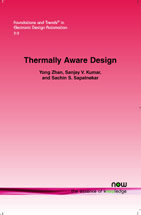Thermally Aware Design
By Yong Zhan, Cadence Design Systems, USA, yongzhan@cadence.com | Sanjay V. Kumar, Department of Electrical and Computer Engineering, University of Minnesota, USA, sanjay@umn.edu | Sachin S. Sapatnekar, Department of Electrical and Computer Engineering, University of Minnesota, USA, sachin@umn.edu
Abstract
With greater integration, the power dissipation in integrated circuits has begun to outpace the ability of today's heat sinks to limit the on-chip temperature. As a result, thermal issues have come to the forefront, and thermally aware design techniques are likely to play a major role in the future. While improved heat sink technologies are available, economic considerations restrict them from being widely deployed until and unless they become more cost-effective. Low power design is helpful in controlling on-chip temperatures, but is already widely utilized, and new thermal-specific approaches are necessary. In short, the onus on thermal management is beginning to move from the package designer toward the chip designer. This survey provides an overview of analysis and optimization techniques for thermally aware design. After beginning with a motivation for the problem and trends seen in the semiconductor industry, the survey presents a description of techniques for on-chip thermal analysis. Next, the effects of elevated temperatures on on-chip performance metrics are analyzed. Finally, a set of thermal optimization techniques, for controlling on-chip temperatures and limiting the level to which they degrade circuit performance, are described.
Thermally-Aware Design
Thermally-Aware Design provides an overview of analysis and optimization techniques for thermally-aware design. After beginning with a motivation for the problem and trends seen in the semiconductor industry, the survey presents a description of techniques for on-chip thermal analysis. Next, the effects of elevated temperatures on on-chip performance metrics are analyzed. Finally, a set of thermal optimization techniques, for controlling on-chip temperatures and limiting the level to which they degrade circuit performance, are described. Thermally-Aware Design is an invaluable reference for researchers and chip designers interested in pushing the state of the art in thermally-aware design techniques.
